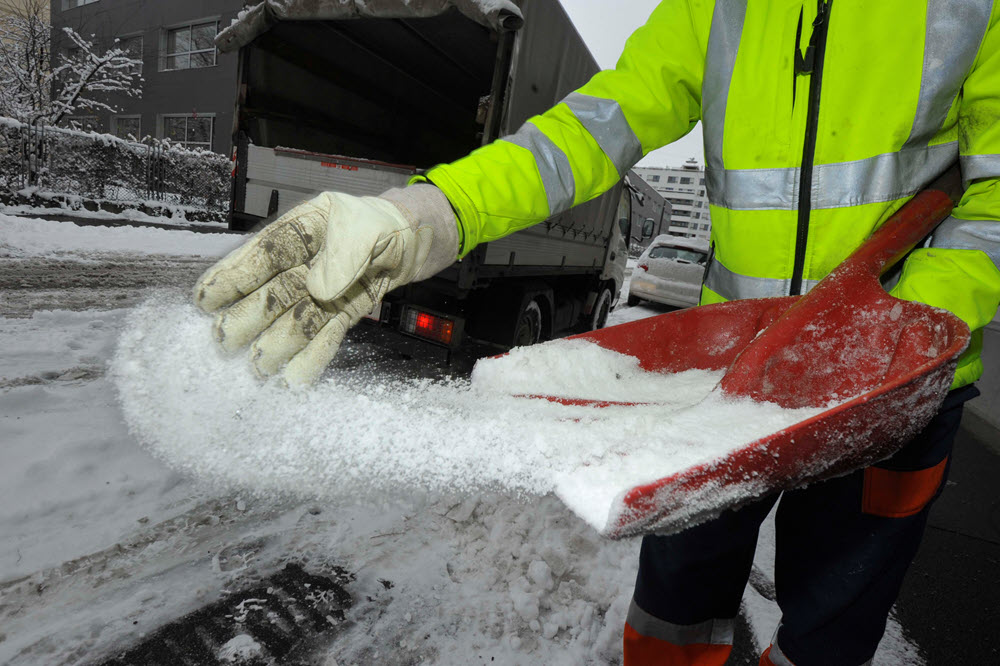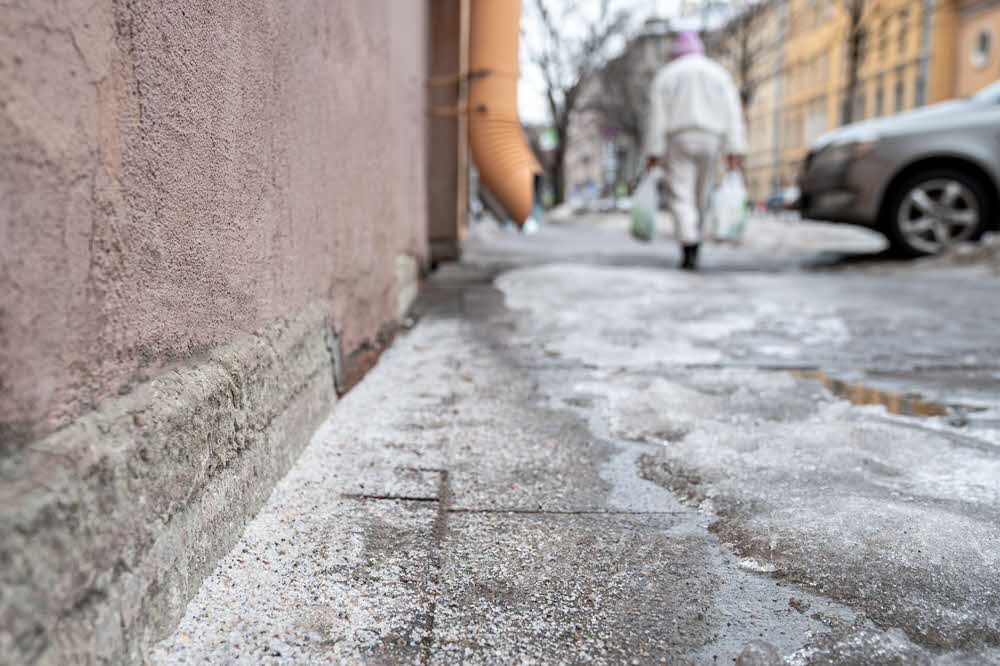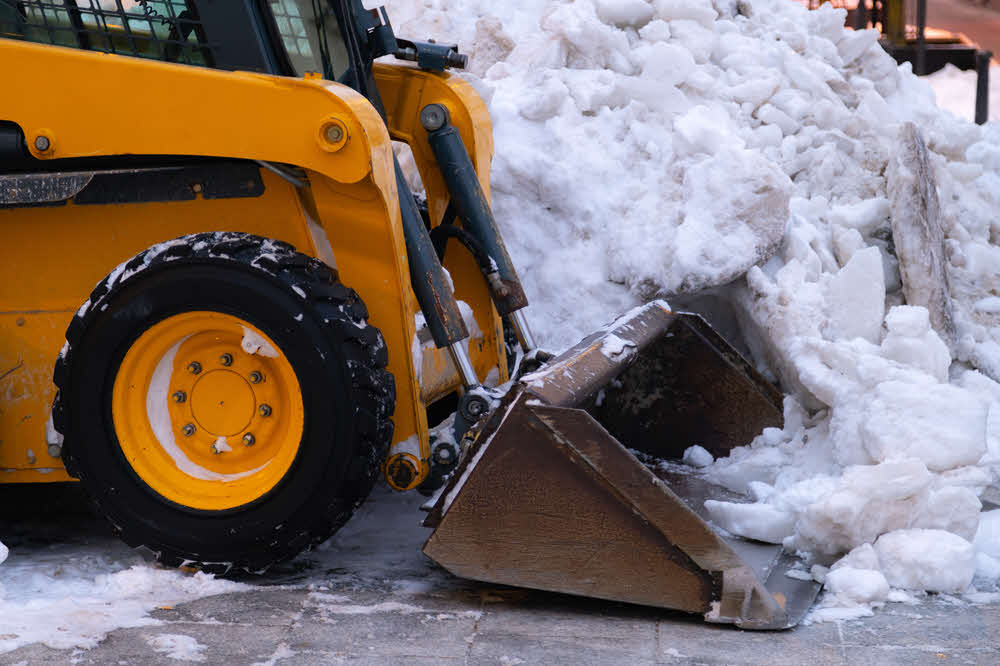Snow Salting Servicesin New Baltimore MI
Prevent Ice HazardsWith Expert Salting Services
We Are Locally Owned & Operated For Over 37 Years
Contact Us Today!
We Serve Businesses In And Around The Following Cities:
About Snow Salting Service
Understanding the Value of Snow Salting Service in New Baltimore
In the heart of winter, one of the tasks that New Baltimore business owners invariably contend with is snow and ice management. As snow blankets commercial properties, it brings with it not just disruptive operational efficiency but also safety issues. The task of snow clearance, however, is burdensome and frequently inconvenient, particularly for businesses that need to be promptly operational for their clients. That’s where the importance of a dependable snow salting service comes into paramount relevance.
The Basics: What Is a Snow Salting Service?
Snow salting service involves the application of coarse salt on walkways, parking lots, sidewalks, and driveways to assist in snow and ice management. Tasked with the job of ensuring your commercial spaces are safe and readily accessible, ice melt application services like D&J Contracting offer a critical function in winter. They transform potentially dangerous surfaces into safe areas that staff, customers, and visitors can navigate confidently.
How Snow Salting Works
Snow salting isn’t just about spreading salt over icy surfaces; it is strategic and methodical. It begins with pre-treating the areas before a snowfall, creating a brine on the surface that prevents ice from bonding to the pavement. This pre-treatment makes the subsequent clearing of snow more manageable. Commercial parking lot salting, business driveway salting, or access sidewalk salting aren’t just haphazard; there’s science and strategy involved to ensure maximum effectiveness. Regular salting throughout the winter season helps to maintain safety and accessibility on your commercial properties.
The Scope of Snow Salting Services
When it comes to snow salting, the scope is expansive and tends to cover all potential slippery surfaces around a business. By providing comprehensive walkway salting services, business driveway salting, and parking lot salting services, providers like D&J Contracting ensure that your customers and employees can get to your door safely. Snow salting even extends to outdoor areas that can become hazardous following snowfalls like staircases, fire exit paths, and loading docks, etc. A noteworthy feature of salting service is attention to detail in every salting project to ensure maximum customer satisfaction.
Unparalleled Benefits of Salting Services
When it comes to managing snow and icy conditions on a commercial property, snow salting presents a multitude of benefits. Foremost, it significantly reduces accidents caused by slips and falls on your premises. Additionally, the service aids businesses in complying with local laws and regulations related to snow removal. Beyond safety and legal compliance, the convenience of having a professional team take care of ice management while you focus on your core business operations is invaluable. Further, it helps avoid expensive lawsuits that may arise due to accidents on your property and safeguards your reputation by showing that you prioritize your customer and employee safety.
Real World Applications of Snow Salting
The power of snow salting services comes alive in numerous real-world applications. For instance, consider a busy shopping complex with extensive parking lots and walkways. Following a heavy snowfall or during an icy winter, navigating these spaces can pose significant danger. By deploying a snow salting service, the shopping complex management can ensure swift and safe navigation for all customers.
Another example involves larger industries with substantial operating facilities. In these settings, ensuring safe movement of staff and machinery is critical, requiring the frequent utilization of business driveway salting and access sidewalk salting. Hence, snow salting quickly becomes an indispensable part of their operational strategy during winter.
Why Choose D&J Contracting?
With the strength of a reliable partner like D&J Contracting, you can navigate the challenges of winter without disruption. Expertise, commitment to quality, and attention to detail make D&J Contracting a trusted choice for a comprehensive snow salting service in New Baltimore. Their commitment to safety and remarkable service delivery makes them a partner of choice.
In essence, winter doesn’t need to stall your business operation or compromise safety. With a dependable partner like D&J Contracting, your snow and ice management becomes swift, operational efficiency remains optimal, and safety takes center stage. As Jack Frost continues to lay a blanket of white across New Baltimore, remember that your business needn’t grind to a halt. A reliable Snow Salting Service is always within reach.
Snow Salting Service Gallery


Call Us Today to receive your Free Quote for
Snow Salting Service in New Baltimore
Serving: New Baltimore, Michigan

About New Baltimore, Michigan
New Baltimore incorporated as a village in 1867 and as a city in 1931. Previously, it was split between Macomb and St. Clair counties; however, in the 1970s, the city was able to petition to adjust the county boundaries such that it would align with the city’s eastern border. This placed New Baltimore completely in Macomb County, where it remains to this day. The town sits on the waterfront along Lake St. Clair’s Anchor Bay, and offers a public park, beach, and downtown-shopping district.
Prior to the arrival of European settlers, indigenous tribes are known to have inhabited much of New Baltimore’s shoreline for thousands of years, and in the 1800s the land was recorded to have many ancient burial mounds and man made earth-works. W.B Hinsdale excavated multiple sites in New Baltimore, and recorded his countless findings in his novels in the early 20th century. Most of these locations have long been destroyed by treasure hunters and developed over, with an unfortunate though seemingly familiar lack of regard to the public’s knowledge of the city’s vast history with indigenous tribes.
German explorer Pierre Yax (b.1763) in Grosse Pointe, New France (now Michigan) was the first recorded non-Native American in the New Baltimore area. Pierre Yax was a son of Johan Michael Jacks, the first German in what would eventually become the state of Michigan. Pierre Yax arrived in New Baltimore in 1796 and subsequently obtained a land grant signed by President John Quincy Adams on July 23, 1826. The land grant tracked back to a land patent Yax had in 1812, when Michigan was still part of the Michigan Territory.
Later, other French settlers came to this area and took residence along the waterfront and rivers. They developed farms that had narrow frontage of 400 of 900 feet and extended inland from the water. Generally, the depth of the parcel was determined by how far a man could plow or cultivate in a day.
The first evidence of a settled community came in 1845, when a Mount Clemens businessman, Alfred Ashley, platted 60 acres (24 ha) of land lying on both sides of Washington Street. This would become known as the village of Ashley. On September 20, 1851, a post office called Ashleyville was established with Ashley as postmaster. Ashley also opened businesses in lumbering, shipping, and real estate. The original village of Ashley occupied what is now the center part of downtown New Baltimore, extending northwest along Clay, Base and Maria Streets from Anchor Bay. The land was subdivided in the typical gridiron fashion used in most American communities at that time. Over the years, irregularities developed in the gridiron subdivision pattern because of the lack of local controls, conflicts with French claims, and changing land uses, particularly along the waterfront area. This created problems in both subdivision patterns in general and waterfront use in particular that remain today. This original settlement bore Ashley’s name until 1867, when the village name was changed to New Baltimore.
Throughout its history, New Baltimore has been linked to the regional economy by virtue of the city’s access to the waterfront and the region’s transportation network. In its early years, New Baltimore took advantage of its waterfront location to operate port facilities exporting agriculture and manufacturing products to other communities. The area was known for the manufacturing of barrels, brooms, bricks, coffins, corsets, and creamery products. Lumber products and building materials were shipped by boat from the local mills. Development was heavily oriented to the waterfront, where shipping piers extended a hundred or more feet into the lake.
As automobile transportation increased in importance and travel patterns changed, so did the development of the city. Goods were no longer shipped by water and the waterfront slowly changed. Between 1860 and 1880, New Baltimore changed from a strong manufacturing and exporting community to a thriving community in Macomb County with many resort activities and well-known commercial establishments. The community was a popular getaway spot for Metro Detroiters and boasted an opera house, hotels, salt baths (which nearby city of Mount Clemens was famous for in the late 19th and early 20th centuries), summer and winter recreational activities, saloons, a brewery and numerous resort and commercial establishments. The city was in the path of a steam locomotive line that ran between Detroit and Port Huron in the late 19th century. As technology changed, the city constructed an electricity plant to accommodate inter-urban passenger trains, which lasted until the mid-1920s. Today, access to the city is provided via Interstate 94. The historic New Baltimore water tower was demolished in the summer of 2015 and raised in the park to take its place was the State’s tallest flag. The flagpole stands at 160 feet tall on the shores of Anchor Bay at Walter and Mary Burke Park. The New Baltimore Lions Club raised more than $100,000 to have the flagpole installed with the intention of creating a landmark for boaters after the city’s historic water tower was demolished. A dedication ceremony took place in October 2016.
New Baltimore is in eastern Macomb County, with its eastern border following the St. Clair County line. It is on the northern shore of Anchor Bay, the northernmost part of Lake St. Clair. Highway M-29 passes through the city as Main Street, leading east 14 miles (23 km) to Algonac on the St. Clair River and west 4 miles (6 km) to Interstate 94 in Chesterfield Township. New Baltimore is 10 miles (16 km) northeast of Mount Clemens, the Macomb county seat.
According to the United States Census Bureau, the city has a total area of 6.73 square miles (17.43 km), of which 4.60 square miles (11.91 km) are land and 2.12 square miles (5.49 km), or 31.6%, are water.
| Census | Pop. | Note | %± |
|---|---|---|---|
| 1880 | 1,024 | — | |
| 1890 | 865 | −15.5% | |
| 1900 | 922 | 6.6% | |
| 1910 | 920 | −0.2% | |
| 1920 | 974 | 5.9% | |
| 1930 | 1,148 | 17.9% | |
| 1940 | 1,434 | 24.9% | |
| 1950 | 2,043 | 42.5% | |
| 1960 | 3,159 | 54.6% | |
| 1970 | 4,132 | 30.8% | |
| 1980 | 5,439 | 31.6% | |
| 1990 | 5,798 | 6.6% | |
| 2000 | 7,405 | 27.7% | |
| 2010 | 12,084 | 63.2% | |
| 2020 | 12,117 | 0.3% | |
| U.S. Decennial Census | |||
As of the census of 2010, there were 12,084 people, 4,434 households, and 3,187 families living in the city. The population density was 2,621.3 inhabitants per square mile (1,012.1/km). There were 4,740 housing units at an average density of 1,028.2 per square mile (397.0/km). The racial makeup of the city was 94.4% White, 2.7% African American, 0.4% Native American, 0.9% Asian, 0.2% from other races, and 1.4% from two or more races. Hispanic or Latino of any race were 1.8% of the population.
There were 4,434 households, of which 41.3% had children under the age of 18 living with them, 60.0% were married couples living together, 8.2% had a female householder with no husband present, 3.6% had a male householder with no wife present, and 28.1% were non-families. 23.3% of all households were made up of individuals, and 9.1% had someone living alone who was 65 years of age or older. The average household size was 2.72 and the average family size was 3.25.
The median age in the city was 37.1 years. 28.8% of residents were under the age of 18; 6.6% were between the ages of 18 and 24; 29.6% were from 25 to 44; 25.1% were from 45 to 64; and 9.8% were 65 years of age or older. The gender makeup of the city was 48.9% male and 51.1% female.
As of the census of 2000, there were 7,405 people, 2,942 households, and 1,994 families living in the city. The population density was 1,604.5 inhabitants per square mile (619.5/km). There were 3,218 housing units at an average density of 697.3 per square mile (269.2/km). The racial makeup of the city was 96.89% White, 0.53% African American, 0.36% Native American, 0.47% Asian, 0.04% Pacific Islander, 0.46% from other races, and 1.27% from two or more races. Hispanic or Latino of any race were 1.34% of the population.
There were 2,942 households, out of which 33.1% had children under the age of 18 living with them, 56.3% were married couples living together, 8.2% had a female householder with no husband present, and 32.2% were non-families. 27.4% of all households were made up of individuals, and 10.4% had someone living alone who was 65 years of age or older. The average household size was 2.48 and the average family size was 3.05.
In the city, the population was spread out, with 25.4% under the age of 18, 6.8% from 18 to 24, 34.3% from 25 to 44, 23.7% from 45 to 64, and 9.7% who were 65 years of age or older. The median age was 36 years. For every 100 females, there were 94.6 males. For every 100 females age 18 and over, there were 92.7 males.
The median income for a household in the city was $60,699, and the median income for a family was $72,046. Males had a median income of $49,648 versus $33,083 for females. The per capita income for the city was $26,921. About 1.0% of families and 3.5% of the population were below the poverty line, including 1.3% of those under age 18 and 8.0% of those age 65 or over.
New Baltimore is a home-rule city with an elected mayor and six at-large council members. Since 2022, Tom Semaan has served as mayor.
The city of New Baltimore is within the boundaries of the Anchor Bay School District, and hosts Lighthouse Elementary, Ashley Elementary, Anchor Bay Middle School North, and Anchor Bay’s Aquatic Center.
Since 2016 the focal point of the community has been Michigan’s largest flag and tallest flagpole. The pole is 160 feet (49 m) high and the American flag it holds is 30 by 60 feet (9.1 by 18.3 m) and sits on the edge of Lake Saint Clair’s Anchor Bay. The $103,000 cost was paid for with donations led by an initial contribution of $10,000 by the New Baltimore Lions Club.
Call Us Today to receive your Free Quote for
Snow Salting Service in New Baltimore
Related Services in New Baltimore, Michigan
We Serve Businesses In The Following Zip Codes:
48007, 48015, 48021, 48026, 48035, 48036, 48038, 48042, 48043, 48044, 48045, 48046, 48047, 48048, 48050, 48051, 48066, 48071, 48080, 48081, 48082, 48083, 48084, 48085, 48088, 48089, 48090, 48091, 48092, 48093, 48098, 48099, 48225, 48230, 48236, 48310, 48311, 48312, 48313, 48314, 48315, 48316, 48317, 48318, 48397